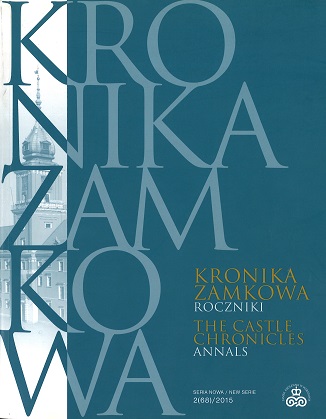Listy Władysława Wazy i inne nieznane źródła do jego europejskiej peregrynacji z archiwów szwedzkich i niemieckich
The letters of Wladyslaw Vasa and other unknown sources related to his European tour in Swedish and German archives
Author(s): Jacek ŻukowskiSubject(s): Fine Arts / Performing Arts, History of Art
Published by: Arx Regia® Wydawnictwo Zamku Królewskiego w Warszawie – Muzeum
Keywords: Władysław IV Vasa; letters; European tour; Urszula Meierin; art patronage; art commissions; early modern travels
Summary/Abstract: This study uncovers fifty-one unknown or forgotten espistolographic sources housed in the Riksarkivet in Stockholm and Munich’s Bayerisches Hauptstaatsarchiv relating to Władysław Zygmunt Vasa’s European tour in the years 1624–1625. Most of the letters were written by the traveller himself, but very illegibly and in a language which can only be described as para-German with strong Austrian influences and some Polish forms—written mainly to Urszula Meierin, the eminence grise of the Vasa court, and also indirectly to his father and stepmother. The remaining letters were written by Ferdinand II, Holy Roman Emperor, and his chamberlain Nicolaus Nussern, Wilhelm V Wittelsbach, Duke of Bavaria, and his son Maximilian I, as well as Archduchess Maria Maddalena of Austria, Grand Duchess of Tuscany. There is important information about the process of preparing for the young Vasa’s visit to Bavaria in the letters written by Prince Johann of Hohenzollern Sigmaringen and Vöhringen, as well as in the writings of the Bavarian commissioners (Johann Praisingen, and Maximilian von Kurtz Senftenau) and the reports of Konstantin Fugger and Nicolas Grosshed. These documents shed light on the complexities of the day-by-day preparations for the Prince’s arrival, details of how the journey was financed and the difficulties encountered while travelling, as well as of the complex system for sending correspondence. The materials contain invaluable information about the protagonist’s impressions of works of art, e.g. in Munich, Augsburg (where he visited the workshop of the goldsmith, Hans Georg Peyerl), in Venice (which he considered the most beautiful place on earth) and in the Southern Netherlands. They abound in details relating to his artistic interests and ambitions as a patron of the arts. For example, in a letter from Brussels, Vasa boasted of having conducted some successful transactions, writing about how he commissioned some new pieces from the local tapestry makers’ workshops and purchased several paintings, including real masterpieces (capolavori). He also emphasized that he endeavoured to buy original works of art, and not the copies appearing on the market. In his correspondence from Bologna, Władysław, the future founder of an operatic theatre, mentions engaging the services of a ‘good organist’ (most probably Giovanni Francesco Anerio) for the royal court, as well as a castrato (Baldassare Ferri). He also expressed his hope of employing a skilled alto.
Journal: Kronika Zamkowa. Roczniki
- Issue Year: 2/2015
- Issue No: 2
- Page Range: 59-122
- Page Count: 64
- Language: Polish

